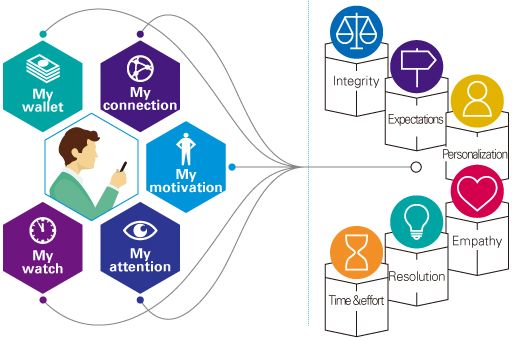Close-up 1: Surviving the perfect storm
Surviving the perfect storm
The transformational “perfect storm” concurrently taking place in the context of regions, demographics, and technologies has been rewriting the rules of businesses everywhere. One of the industries most deeply influenced is the consumer and retail sector.
Consumers nowadays wish and expect to buy what they want immediately. Their questions have changed from “what to buy” to “how,” “when,” “where,” and “from whom” to buy, and even further “how they rate and share”. The level of their demands has been continuously rising. In the era of technologies this article explores the possible directions of transformation in order for companies to meet new, diversifying consumer demands.
Getting started to know your customers
A new class of giant IT companies called platformers and their ecosystems with which they provide large-scale services on the internet have emerged in an era of technology-driven, fast-evolving changes. The platformers have achieved a great deal within a short span of time by deepening their presence and intensifying many ideas, resources, clients and data through alliances with others. Convenient services from the giant platformers that provide everything consumers need on a one-stop-shop basis may discourage them from moving to other providers. Aggressive entries of technology-savvy startups which targeting the millennial and post-millennial generations have also driven the market growth.
The current keyword is “growth”. Have a company’s corporate culture, strategies, and business model been agile enough to meet current customer demands? Does the digitalization and use of smart technologies really contribute to the company’s growth? Companies must authentically understand their customers, come closer to them, and provide them with the best proposals and experiences that match their individual situations. Only the companies that are able to transform themselves through a customer-centric way can achieve high growth and performance.
While the phases of “cognition,” “consideration,” “conversion (purchase of goods),” and “assessment” in consumption still proceed in the same order, the nature of each has significantly changed on the back of the penetration of the internet, digital innovation, and the online shopping boom. The evolution of a touch point from offline, TV and media advertisement to online, mobile, and social networking service (SNS) has brought about a more complicated purchasing process that proceeds not linearly, but multi-directionally like the branches of a web, with repeated transitions between offline and online activities. The experiences provided to consumers through various customer journeys, and the associated empathy and relationships built up in the process, are more important than ever before.
The “Five My” concept to understand diversified consumers
In the digital world, with its evolving technologies and ever-growing data trail, consumers expect companies to offer customized proposals on what to purchase based on the understanding of individual customers and their purchasing behaviors, and companies are also aiming to realize the system to meet that need. KPMG advocates the “Five My” concept in analyzing consumers: My “Motivation,” My “Attention,” My “Connection,” My “Watch,” and My “Wallet.” By focusing on the Five My’s in analyzing customers’ life stages, life events, and the mutual interactions among them, you can piece together images and profiles of current and future individual consumers with a level of detail that cannot be matched by demographic analyses. An understanding of the true factors tied to the diversified behaviors of consumers and the significant tradeoffs in the purchase decisions consumers make may enable you to specifically access consumers with a precision never before attained.
Launch walk-through experiences of customers

Source : KPMG International “Me, My Life, My Wallet Issue 2” issued in April 2019
Successful inter-generational surfing: Millennials and generation Z
When surfing you must decide whether to act fast and ride the next wave or bide your time on the current wave, waiting until it subsides before you change to another. A company can grasp the waves of need that come and go in a consumer’s life if it understands the stages of life the consumer passes through - the passage from youth to adulthood, the child-rearing era, the empty-nester period, the golden years of retirement, etc. - and determine the patterns of change that take place stage by stage. Alternatively, a company can conquer the surfing challenge by placing a focus on a specific life stage and catching the wave of the new generation entering that stage. Of course the company must understand that people of the same generation may have very different notions of life events or may time them differently. Established business models are likely to be ill-suited to catching the next waves. Are companies really ready to accept millennials and generation Z as customers?
The millennials born in the 1980s to early 2000s are said to place little weight on driving licenses and car ownership. In previous generations, these attainments were evidence that one has become an adult. For a millennial, the first-time use and possession of a smartphone is a very important life event and the mobile and online spaces are channels for connecting with others. The millennials are more inclined to use car-sharing services, mobility rentals, and on-demand traffic modes. The timing for marriage, first home purchase, and delivery of a first child is now being further deferred, and marriage rate and birth rate have both decreased.
The members of generation Z, born after the year 2000, are familiar with computer games as their parents are used to playing them. Now online gaming enables them to live another ego of their lives through online game avatars in virtual reality. The boom game “Fortnite” has achieved monthly sales of 300 million dollars solely from in-app sales of items.
Gamers enjoy Fortnite with friends and use their pocket money to buy skins (changeable costumes covering the whole body). The online space is where they can express their “true selves.” For the members of generation Z, who are versatile with media and can freely move among devices and contents while viewing multiple YouTube programs concurrently, tie-in is a “new normal.” Moving back and forth between a game and movie, then visiting YouTube, then jumping over to retailing sites selling toys or apparel, is a normal sequence of actions.
What is required is“non-linear transformation”
As information and things become more abundant in society, companies face growing difficulty in having customers select their goods and services. Unless customers can identify the “attractive aspects” of goods and services and understand the “reasons” for obtaining them in empathic ways through sharing with others, the threshold for selection tends to narrow down to the price alone. The points that attract the interests and empathies of customers are diverse and compound, ranging from quality, price, design, function, convenience to the environment, health, and the social activities and philosophy of the companies that provide them. Balance among these points is also key.
To understand customers, and develop and establish relationships between companies and customers, it will become more important to enhance the branding images and make themselves better known to their customers by having the touch points by themselves, which were formerly delegated to retailers and dealers. Note also that the customer incentive to purchase goods and services may often lie outside of the goods and services themselves. For double-income parents perpetually pressed for time and in need of help, for example, convenience throughout the customer journey is key. If companies can fully make their whole supply chain complete and simple with mobile applications and provide communities online that parents can turn to for support in their constant struggles to meet the demands of parenting and work, companies can attract them as customers and maintain their loyalty.
For whatever sectors, the notion of “Think like a start-up” will be key to addressing the non-linear transformation. First, consider who you would target as customers if you started up a business from scratch. Next, ask yourself how you would use digital environments and technologies, and what business models you would wish to develop. Given their existing resources, their workforces and assets, companies that operate established businesses tend to rule out the range of options open to them too readily by dismissing strategies that they believe would impair the productivity of their current resources. It is the dilemma of innovation, and a typical case is the cannibalization of sales between the offline and online modes.
Companies should compare the natural consequences when they interminably delay the necessary transformation with those when they make the transformation on a whole corporate value basis. Management must act not just with courage and guts, but with a commitment to optimizing corporate value not partially, but holistically.
As diversified customers change, a useful strategy to address it might be to adjust the key performance indicators (KPIs). Instead of judging performance by sales at an individual shop, for example, the judgment could be based on sales to an individual customer or a customer’s level of satisfaction. With these performance indicators, sales could be realistically valued regardless of whether they take place online or offline.
Companies may find it effective to incubate new business seeds under separate organizations by setting up corporate venture capital, or acquiring businesses all at once through M&A arrangements.
Many of these approaches may require abundant funding and investment periods of a few years. By the time a company clearly perceives disruptions to its existing business, it may be too late to commence these approaches. Any company that does not meet the expectations of its customers will be extinguished. Existing companies now stand at a point of disruption. Therefore they must act now by disrupting existing businesses themselves, and executing non-linear transformational changes.
Author
Yoshinobu Nakamura
Lead, Consumer & retail, KPMG in Japan
Partner, KPMG FAS Co., Ltd.
For more than 20 years with KPMG, Yoshinobu Nakamura has been engaged in various projects ranging from M&As, to JV formation, reorganization and restructuring of businesses, overseas market entries/withdrawals and business transformation. He has mainly helped consumer and retail sector clients in their corporate combination, group-wide restructuring, business plan development and new business development. As head of Restructuring, KPMG Japan, he oversees assistance to organizations under voluntary or legal liquidation process, publicly supported institutions as well as troubled companies for their turnaround and consolidation.
© 2024 KPMG AZSA LLC, a limited liability audit corporation incorporated under the Japanese Certified Public Accountants Law and a member firm of the KPMG global organization of independent member firms affiliated with KPMG International Limited, a private English company limited by guarantee. All rights reserved. © 2024 KPMG Tax Corporation, a tax corporation incorporated under the Japanese CPTA Law and a member firm of the KPMG global organization of independent member firms affiliated with KPMG International Limited, a private English company limited by guarantee. All rights reserved.
For more detail about the structure of the KPMG global organization please visit https://kpmg.com/governance.

